锂基脂MSDS
- 格式:xls
- 大小:21.50 KB
- 文档页数:3
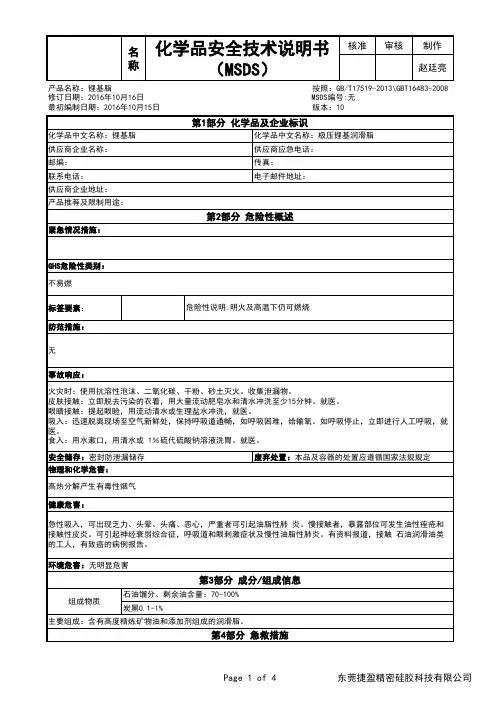
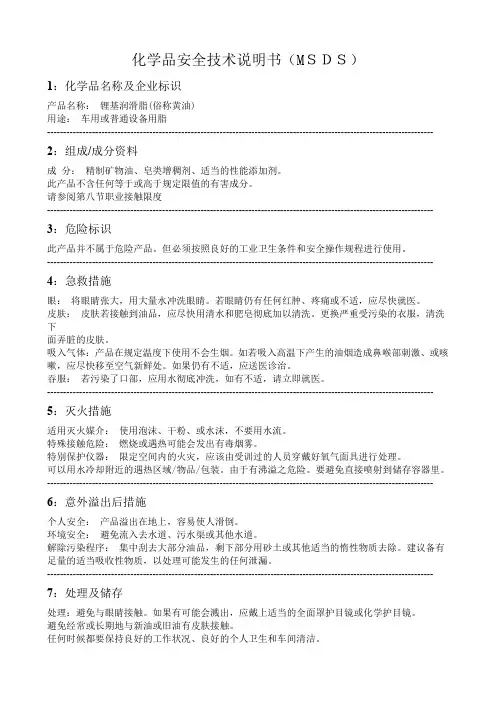
化学品安全技术说明书(MSDS)1:化学品名称及企业标识产品名称:锂基润滑脂(俗称黄油)用途:车用或普通设备用脂-------------------------------------------------------------------------------------------------------------------------2:组成/成分资料成分:精制矿物油、皂类增稠剂、适当的性能添加剂。
此产品不含任何等于或高于规定限值的有害成分。
请参阅第八节职业接触限度-------------------------------------------------------------------------------------------------------------------------3:危险标识此产品并不属于危险产品。
但必须按照良好的工业卫生条件和安全操作规程进行使用。
-------------------------------------------------------------------------------------------------------------------------4:急救措施眼:将眼睛张大,用大量水冲洗眼睛。
若眼睛仍有任何红肿、疼痛或不适,应尽快就医。
皮肤:皮肤若接触到油品,应尽快用清水和肥皂彻底加以清洗。
更换严重受污染的衣服,清洗下面弄脏的皮肤。
吸入气体:产品在规定温度下使用不会生烟。
如若吸入高温下产生的油烟造成鼻喉部刺激、或咳嗽,应尽快移至空气新鲜处。
如果仍有不适,应送医诊治。
吞服:若污染了口部,应用水彻底冲洗,如有不适,请立即就医。
-------------------------------------------------------------------------------------------------------------------------5:灭火措施适用灭火媒介:使用泡沫、干粉、或水沫,不要用水流。
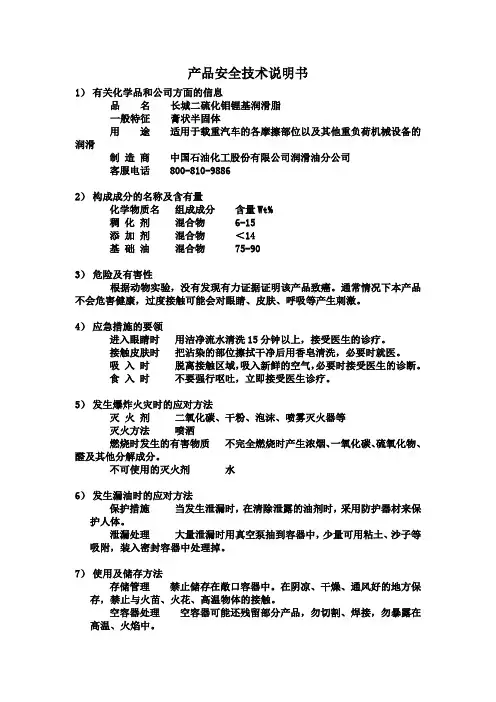
产品安全技术说明书1)有关化学品和公司方面的信息品名长城二硫化钼锂基润滑脂一般特征膏状半固体用途适用于载重汽车的各摩擦部位以及其他重负荷机械设备的润滑制造商中国石油化工股份有限公司润滑油分公司客服电话 800-810-98862)构成成分的名称及含有量化学物质名组成成分含量Wt%稠化剂混合物 6-15添加剂混合物<14基础油混合物 75-903)危险及有害性根据动物实验,没有发现有力证据证明该产品致癌。
通常情况下本产品不会危害健康,过度接触可能会对眼睛、皮肤、呼吸等产生刺激。
4)应急措施的要领进入眼睛时用洁净流水清洗15分钟以上,接受医生的诊疗。
接触皮肤时把沾染的部位擦拭干净后用香皂清洗,必要时就医。
吸入时脱离接触区域,吸入新鲜的空气,必要时接受医生的诊断。
食入时不要强行呕吐,立即接受医生诊疗。
5)发生爆炸火灾时的应对方法灭火剂二氧化碳、干粉、泡沫、喷雾灭火器等灭火方法喷洒燃烧时发生的有害物质不完全燃烧时产生浓烟、一氧化碳、硫氧化物、醛及其他分解成分。
不可使用的灭火剂水6)发生漏油时的应对方法保护措施当发生泄漏时,在清除泄露的油剂时,采用防护器材来保护人体。
泄漏处理大量泄漏时用真空泵抽到容器中,少量可用粘土、沙子等吸附,装入密封容器中处理掉。
7)使用及储存方法存储管理禁止储存在敞口容器中。
在阴凉、干燥、通风好的地方保存,禁止与火苗、火花、高温物体的接触。
空容器处理空容器可能还残留部分产品,勿切割、焊接,勿暴露在高温、火焰中。
8)防止泄露及个人防护管理方法尽量存放在室内,使用后确认封口密封,防止油液泄露。
对呼吸道的防护高浓度区域请使用防毒口罩对眼睛防护请使用保护眼镜对手的防护请使用耐油性、耐化学性的防护手套对身体保护请使用非渗透性的安全服装及安全鞋卫生注意事项作业后用水清洗,擦拭护肤霜来保护皮肤9)物理化学特性外观黑色均匀软膏气味无异味工作锥入度,0.1mm 220-250滴点≥185℃10)安全性及反应性稳定性稳定(室温)保管要求远离强氧化剂、火源等有害分解物质周围环境温度下不会分解聚合反应不发生11)有关毒性方面的信息毒害信息急性经口毒性实验(一次最大限度实验)雌性、雄性小鼠LD50均大于5000mg/kgBW,为实际低毒。
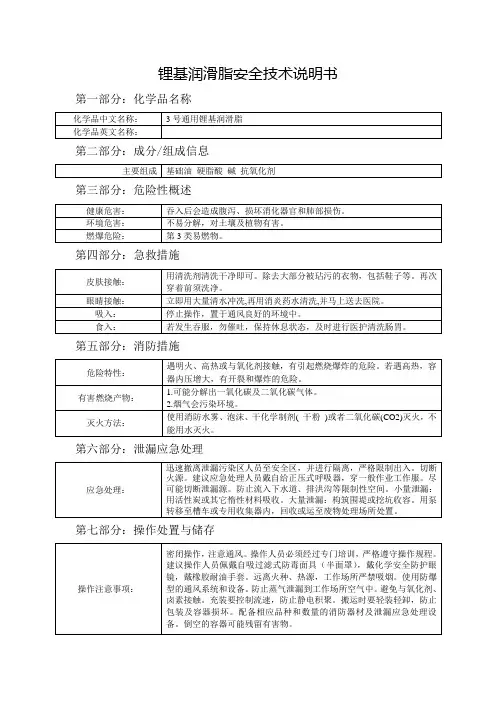
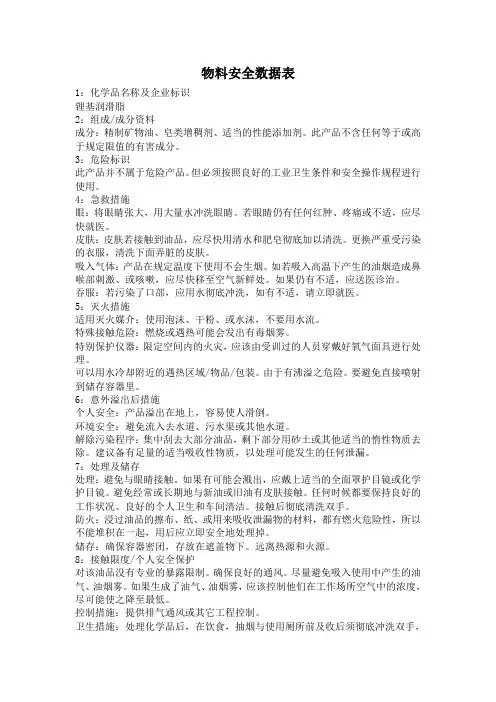
物料安全数据表1:化学品名称及企业标识锂基润滑脂2:组成/成分资料成分:精制矿物油、皂类增稠剂、适当的性能添加剂。
此产品不含任何等于或高于规定限值的有害成分。
3:危险标识此产品并不属于危险产品。
但必须按照良好的工业卫生条件和安全操作规程进行使用。
4:急救措施眼:将眼睛张大,用大量水冲洗眼睛。
若眼睛仍有任何红肿、疼痛或不适,应尽快就医。
皮肤:皮肤若接触到油品,应尽快用清水和肥皂彻底加以清洗。
更换严重受污染的衣服,清洗下面弄脏的皮肤。
吸入气体:产品在规定温度下使用不会生烟。
如若吸入高温下产生的油烟造成鼻喉部刺激、或咳嗽,应尽快移至空气新鲜处。
如果仍有不适,应送医诊治。
吞服:若污染了口部,应用水彻底冲洗,如有不适,请立即就医。
5:灭火措施适用灭火媒介:使用泡沫、干粉、或水沫,不要用水流。
特殊接触危险:燃烧或遇热可能会发出有毒烟雾。
特别保护仪器:限定空间内的火灾,应该由受训过的人员穿戴好氧气面具进行处理。
可以用水冷却附近的遇热区域/物品/包装。
由于有沸溢之危险。
要避免直接喷射到储存容器里。
6:意外溢出后措施个人安全:产品溢出在地上,容易使人滑倒。
环境安全:避免流入去水道、污水渠或其他水道。
解除污染程序:集中刮去大部分油品,剩下部分用砂土或其他适当的惰性物质去除。
建议备有足量的适当吸收性物质,以处理可能发生的任何泄漏。
7:处理及储存处理:避免与眼睛接触。
如果有可能会溅出,应戴上适当的全面罩护目镜或化学护目镜。
避免经常或长期地与新油或旧油有皮肤接触。
任何时候都要保持良好的工作状况、良好的个人卫生和车间清洁。
接触后彻底清洗双手。
防火:浸过油品的擦布、纸、或用来吸收泄漏物的材料,都有燃火危险性,所以不能堆积在一起,用后应立即安全地处理掉。
储存:确保容器密闭,存放在遮盖物下。
远离热源和火源。
8:接触限度/个人安全保护对该油品没有专业的暴露限制。
确保良好的通风。
尽量避免吸入使用中产生的油气、油烟雾。
如果生成了油气、油烟雾,应该控制他们在工作场所空气中的浓度,尽可能使之降至最低。
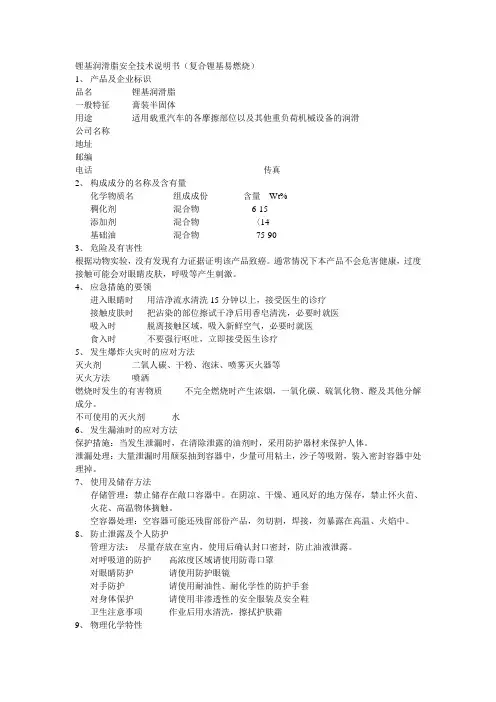
锂基润滑脂安全技术说明书(复合锂基易燃烧)1、产品及企业标识品名锂基润滑脂一般特征膏装半固体用途适用载重汽车的各摩擦部位以及其他重负荷机械设备的润滑公司名称地址邮编电话传真2、构成成分的名称及含有量化学物质名组成成份含量Wt%稠化剂混合物6-15添加剂混合物〈14基础油混合物75-903、危险及有害性根据动物实验,没有发现有力证据证明该产品致癌。
通常情况下本产品不会危害健康,过度接触可能会对眼睛皮肤,呼吸等产生刺激。
4、应急措施的要领进入眼睛时用洁净流水清洗15分钟以上,接受医生的诊疗接触皮肤时把沾染的部位擦试干净后用香皂清洗,必要时就医吸入时脱离接触区域,吸入新鲜空气,必要时就医食入时不要强行呕吐,立即接受医生诊疗5、发生爆炸火灾时的应对方法灭火剂二氧人碳、干粉、泡沫、喷雾灭火器等灭火方法喷洒燃烧时发生的有害物质不完全燃烧时产生浓烟,一氧化碳、硫氧化物、醛及其他分解成分。
不可使用的灭火剂水6、发生漏油时的应对方法保护措施:当发生泄漏时,在清除泄露的油剂时,采用防护器材来保护人体。
泄漏处理:大量泄漏时用颠泵抽到容器中,少量可用粘土,沙子等吸附,装入密封容器中处理掉。
7、使用及储存方法存储管理:禁止储存在敞口容器中。
在阴凉、干燥、通风好的地方保存,禁止怀火苗、火花、高温物体摘触。
空容器处理:空容器可能还残留部份产品,勿切割,焊接,勿暴露在高温、火焰中。
8、防止泄露及个人防护管理方法:尽量存放在室内,使用后确认封口密封,防止油液泄露。
对呼吸道的防护高浓度区域请使用防毒口罩对眼睛防护请使用防护眼镜对手防护请使用耐油性、耐化学性的防护手套对身体保护请使用非渗透性的安全服装及安全鞋卫生注意事项作业后用水清洗,擦拭护肤霜9、物理化学特性外观红色均匀软膏(红、蓝、黄)气味无异味工作锥入度0.1mm 220-250滴点≥185℃10、安全性及反应性稳定性稳定(室温)保管要求远离强氧化剂、火源等有害分解物质周围环境温度下不会分解聚合反应不发生11、有关毒性方面信息毒害信息急性经口毒性实验(一次最大限度实验)雌性、雄性小鼠LD50均大于5000mg/kgBW,为实际低毒。
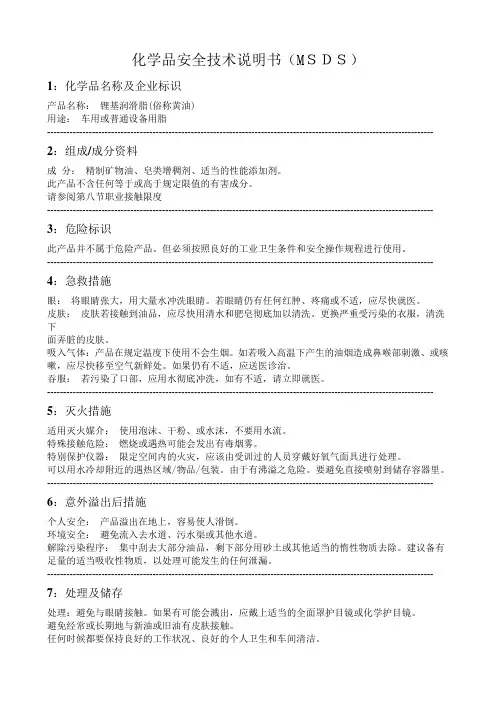
化学品安全技术说明书(MSDS)1:化学品名称及企业标识产品名称:锂基润滑脂(俗称黄油)用途:车用或普通设备用脂-------------------------------------------------------------------------------------------------------------------------2:组成/成分资料成分:精制矿物油、皂类增稠剂、适当的性能添加剂。
此产品不含任何等于或高于规定限值的有害成分。
请参阅第八节职业接触限度-------------------------------------------------------------------------------------------------------------------------3:危险标识此产品并不属于危险产品。
但必须按照良好的工业卫生条件和安全操作规程进行使用。
-------------------------------------------------------------------------------------------------------------------------4:急救措施眼:将眼睛张大,用大量水冲洗眼睛。
若眼睛仍有任何红肿、疼痛或不适,应尽快就医。
皮肤:皮肤若接触到油品,应尽快用清水和肥皂彻底加以清洗。
更换严重受污染的衣服,清洗下面弄脏的皮肤。
吸入气体:产品在规定温度下使用不会生烟。
如若吸入高温下产生的油烟造成鼻喉部刺激、或咳嗽,应尽快移至空气新鲜处。
如果仍有不适,应送医诊治。
吞服:若污染了口部,应用水彻底冲洗,如有不适,请立即就医。
-------------------------------------------------------------------------------------------------------------------------5:灭火措施适用灭火媒介:使用泡沫、干粉、或水沫,不要用水流。
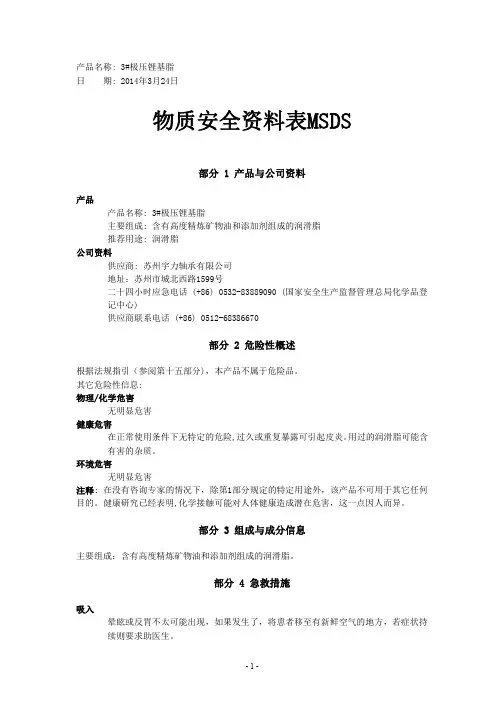
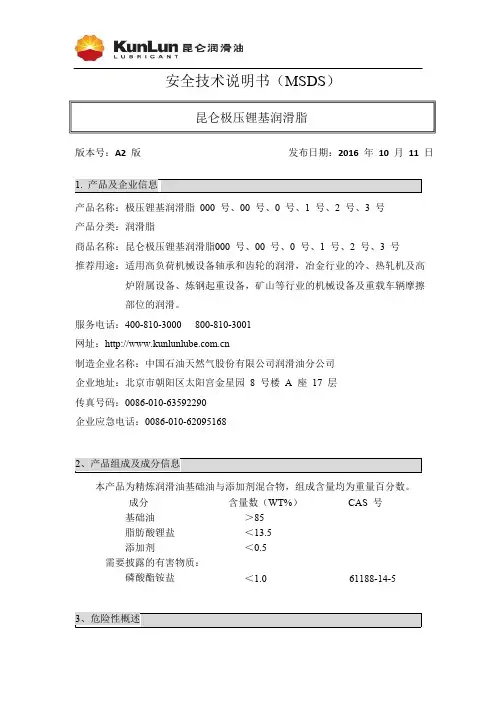
安全技术说明书(MSDS )昆仑极压锂基润滑脂版本号:A2 版 发布日期:2016 年 10 月 11 日产品名称:极压锂基润滑脂 000 号、00 号、0 号、1 号、2 号、3 号产品分类:润滑脂商品名称:昆仑极压锂基润滑脂000 号、00 号、0 号、1 号、2 号、3 号推荐用途:适用高负荷机械设备轴承和齿轮的润滑,冶金行业的冷、热轧机及高炉附属设备、炼钢起重设备,矿山等行业的机械设备及重载车辆摩擦部位的润滑。
服务电话:400-810-3000 800-810-3001网址:制造企业名称:中国石油天然气股份有限公司润滑油分公司企业地址:北京市朝阳区太阳宫金星园 8 号楼 A 座 17 层传真号码:0086-010-********企业应急电话:0086-010-********本产品为精炼润滑油基础油与添加剂混合物,组成含量均为重量百分数。
成分基础油脂肪酸锂盐添加剂需要披露的有害物质:磷酸酯铵盐含量数(WT%) >85 <13.5 <0.5<1.0 CAS 号 61188-14-5根据化学品分类和危险性公示通则(GB 13690-2009)以及危险货物品名表(GB 12268-2005),本产品不属于危险品。
在正常使用的情况下,本产品不存在不可预计的危险。
物理/化学危险性类别:不归为危险物质。
健康危险性类别:无明显危害。
健康危害:高压射向皮肤可能会造成严重损伤,过度接触会造成眼部、皮肤或呼吸刺激。
环境危害:无明显危害。
食入时:饮足量温水,催吐,大量吞服者,应立即送医院诊治,在医师的指导下采取催吐或其它的救护措施。
眼睛接触:立即翻开上、下眼睑,用流动清水或生理盐水冲洗,若发生持续刺激,则需就医。
皮肤接触:脱去污染的衣着,用肥皂和大量流动清水洗净被污染的部分。
如果产品被注入皮下或者人体任何部位,无论伤口的外观或大小,必须立即送医院进行外科检查治疗。
危险特性:本产品遇明火、高热或与氧化剂接触可能引起燃烧。

Revision Date:2Feb2021SDS Number:SDHXSDS2103EN Issue Date:2Feb2021Version:1.00____________________________________________________________________________________________________________________________________SAFETY DATA SHEET1.PRODUCT AND COMPANY IDENTIFICATIONProduct Name:Lithium grease semifluid,XingpuProduct Code:noneRecommended Use:Lubricating GreaseManufacturer or supplier's detailsSupplier:Shandong Honsing Chemical Co.,Ltd.Xinxing Industrial ZoneGuangrao CountyDongying257335China24Hour Emergency Telephone(+86)532-83889090Supplier General Contact(+86)546-2952012800-8609178E-Mail hxhgxuhui@FAX(+86)546-2952026Recommended use of the chemical and restrictions on useRecommended use:Automotive and industrial greaseEMERGENCY OVERVIEWAppearance Semi-solid at ambient temperature.Colour YellowOdour Slight petroleumHealth Hazards Not classified as dangerous for supply or conveyance.High-pressure injection under the skin may cause serious damage including localnecrosis.Safety Hazards Not classified as flammable but will burn.Environmental Hazards Not classified as dangerous for the environment.GHS ClassificationBased on available data this substance/mixture does not meet the classification criteria.GHS label elementsHazard pictograms:No Hazard Symbol requiredSignal word:No signal wordHazard statements:Revision Date:2Feb 2021SDS Number:SDHXSDS2103EN Issue Date:2Feb 2021Version:1.00____________________________________________________________________________________________________________________________________PHYSICAL HAZARDS:Not classified as a physical hazard under GHS criteria.HEALTH HAZARDS:Not classified as a health hazard under GHS criteria.ENVIRONMENTAL HAZARDS:Not classified as an environmental hazard under GHS criteria.Precautionary statements :Prevention:No precautionary phrases.Response:No precautionary phrases.Storage:No precautionary phrases.Disposal:No precautionary phrases.Other hazards which do not result in classificationProlonged or repeated skin contact without proper cleaning can clog the pores of the skin resulting in disorders such as oil acne/ed grease may contain harmfulimpurities.High-pressure injection under the skin may cause serious damage including local necrosis.Not classified as flammable but will burn.Physical and chemical hazards Not classifiedas flammable but will burn.Health Hazards Inhalation:Under normal conditions of use,this is not expected to bea primary route of exposure.Skin:Prolonged or repeated skin contactwithout proper cleaning can clog the pores of the skin resulting indisorders such as oil acne/folliculitis.Eyes:May cause slight irritationto eyes.Ingestion:Low toxicity if swallowed.Environmental Hazards Not classified as dangerous for the environment.Chemical nature :A lubricating grease containing highly-refined mineral oils and additives.Thehighly refined mineral oil contains <3%(w/w)DMSO extract,according to IP346.Hazardous componentsChemical NameCAS#Concentration,%Classification BENZENAMINE,N-PHENYL-,REACTIONPRODUCTS WITH 2,4,4-TRIMETHYLPENTENEAND 2-methylpropene 184378-08-30.1-1.0Acute Env Tox.3;H402Chronic Env Tox.3;H412For explanation of abbreviations see section 16.Revision Date:2Feb2021SDS Number:SDHXSDS2103EN Issue Date:2Feb2021Version:1.00FIRST AID:INHALATIONUnder normal conditions of intended use,this material is not expected to be an inhalation hazard.SKIN CONTACTWash contact areas with soap and water.If product is injected into or under the skin,or into any part of the body,regardless of the appearance of the wound or its size,the individual should be evaluated immediately by a physician as a surgical emergency.Even though initial symptoms from high pressure injection may be minimal or absent,early surgical treatment within the first few hours may significantly reduce the ultimate extent of injury.EYE CONTACTFlush thoroughly with water.If irritation occurs,get medical assistance.INGESTIONFirst aid is normally not required.Seek medical attention if discomfort occurs.IMPORTANT SYMPTOMS AND HEALTH EFFECTSLocal necrosis as evidenced by delayed onset of pain and tissue damage a few hours after injection.ADVICE TO PROTECT RESCUERPlease refer to Section8for personal protection information.NOTE TO PHYSICIANThe need to have special means for providing specific and immediate medical treatment available in the workplace is not expected.Suitable extinguishing media:Foam,water spray or fog.Dry chemical powder,carbon dioxide,sand or earthmay be used for small fires only.Unsuitable extinguishing media:Do not use water in a jet.Specific hazards during firefighting:Hazardous combustion products may include:A complex mixture of airbornesolid and liquid particulates and gases(smoke).Carbon monoxide may beevolved if incomplete combustion occurs.Unidentified organic and inorganiccompounds.Specific extinguishing methods:Use extinguishing measures that are appropriate to local circumstances andthe surrounding environment.Special protective equipment for firefighters:Revision Date:2Feb2021SDS Number:SDHXSDS2103EN Issue Date:2Feb2021Version:1.00____________________________________________________________________________________________________________________________________Proper protective equipment including chemical resistant gloves are to beworn;chemical resistant suit is indicated if large contact with spilledproduct is expected.Self-Contained Breathing Apparatus must be worn whenapproaching a fire in a confined space.Select fire fighter's clothingapproved to relevant Standards(e.g.Europe:EN469).Personal precautions,protective equipment and emergency procedures:Avoid contact with skin and eyes.Environmental precautions:Use appropriate containment to avoid environmental contamination.Preventfrom spreading or entering drains,ditches or rivers by using sand,earth,or other appropriate barriers.Methods and materials for containment and cleaning up:Shovel into a suitable clearly marked container for disposal or reclamationin accordance with local regulations.Additional advice:For guidance on selection of personal protective equipment see Chapter8of this Safety Data Sheet.For guidance on disposal of spilled materialsee Chapter13of this Safety Data Sheet.HANDLINGHandling General Precautions:Use local exhaust ventilation if there is risk of inhalation of vapours,mists or e the information in this data sheet as input to arisk assessment of local circumstances to help determine appropriatecontrols for safe handling,storage and disposal of this material. Advice on safe handling:Avoid prolonged or repeated contact with skin.Avoid inhaling vapour and/ormists.When handling product in drums,safety footwear should be worn andproper handling equipment should be used.Properly dispose of anycontaminated rags or cleaning materials in order to prevent fires. Avoidance of contact:Strong oxidising agents.STORAGEOther data:Keep container tightly closed and in a cool,well-ventilated eproperly labeled and closable containers.Store at ambient temperature. Packaging material:Suitable material:For containers or container linings,use mild steelor high density polyethylene.Unsuitable material:PVC.Container Advice:Polyethylene containers should not be exposed to high temperatures becauseof possible risk of distortion.Components with workplace control parametersRevision Date:2Feb2021SDS Number:SDHXSDS2103EN Issue Date:2Feb2021Version:1.00____________________________________________________________________________________________________________________________________Components CAS-No.Value type(Form ofexposure)Control parameters/Permissible concentrationBasisOil mist,mineral Not Assigned TWA(Mist)5mg/m3OSHA Z-1Oil mist,mineral Not Assigned TWA(Inhalable fraction)5mg/m3ACGIH Biological occupational exposure limitsNo biological limit allocated.Monitoring MethodsMonitoring of the concentration of substances in the breathing zone ofworkers or in the general workplace may be required to confirm compliancewith an OEL and adequacy of exposure controls.For some substancesbiological monitoring may also be appropriate.Validated exposuremeasurement methods should be applied by a competent person and samplesanalysed by an accredited laboratory.Examples of sources of recommendedexposure measurement methods are given below or contact the supplier.Further national methods may be available.National Institute ofOccupational Safety and Health(NIOSH),USA:Manual of Analytical Methods/niosh/Occupational Safety and Health Administration(OSHA),USA:Sampling and Analytical Methods /Healthand Safety Executive(HSE),UK:Methods for the Determination of HazardousSubstances /Institut für Arbeitsschutz DeutschenGesetzlichen Unfallversicherung(IFA),Germanyhttp://www.dguv.de/inhalt/index.jsp L'Institut National de Recherche etde Securité,(INRS),France http://www.inrs.fr/accueilEngineering measures:The level of protection and types of controls necessary will vary dependingupon potential exposure conditions.Select controls based on a riskassessment of local circumstances.Appropriate measures include:Adequate ventilation to control airborne concentrations.Where materialis heated,sprayed or mist formed,there is greater potential for airborneconcentrations to be generated.General Information:Define proceduresfor safe handling and maintenance of cate and train workersin the hazards and control measures relevant to normal activitiesassociated with this product.Ensure appropriate selection,testing andmaintenance of equipment used to control exposure, e.g.personalprotective equipment,local exhaust ventilation.Drain down system priorto equipment break-in or maintenance.Retain drain downs in sealed storagepending disposal or subsequent recycle.Always observe good personalhygiene measures,such as washing hands after handling the material andbefore eating,drinking,and/or smoking.Routinely wash work clothing andprotective equipment to remove contaminants.Discard contaminatedclothing and footwear that cannot be cleaned.Practice good housekeeping.Due to the product's semi-solid consistency,generation of mists and dustsis unlikely to occur.Personal protective equipmentProtective measuresRevision Date:2Feb2021SDS Number:SDHXSDS2103EN Issue Date:2Feb2021Version:1.00____________________________________________________________________________________________________________________________________Personal protective equipment(PPE)should meet recommended nationalstandards.Check with PPE suppliers.Respiratory protection:No respiratory protection is ordinarily required under normal conditionsof use.In accordance with good industrial hygiene practices,precautions shouldbe taken to avoid breathing of material.If engineering controls do notmaintain airborne concentrations to a level which is adequate to protectworker health,select respiratory protection equipment suitable for thespecific conditions of use and meeting relevant legislation.Check withrespiratory protective equipment suppliers.Where air-filteringrespirators are suitable,select an appropriate combination of mask andfilter.Select a filter suitable for the combination of organic gases andvapours[Type A/Type P boiling point>65°C(149°F)].Hand protection Remarks:Where hand contact with the product may occur the use of gloves approvedto relevant standards(e.g.Europe:EN374,US:F739)made from thefollowing materials may provide suitable chemical protection.PVC,neoprene or nitrile rubber gloves Suitability and durability of a gloveis dependent on usage,e.g.frequency and duration of contact,chemicalresistance of glove material,dexterity.Always seek advice from glovesuppliers.Contaminated gloves should be replaced.Personal hygiene isa key element of effective hand care.Gloves must only be worn on cleanhands.After using gloves,hands should be washed and dried thoroughly.Application of a non-perfumed moisturizer is recommended.For continuouscontact we recommend gloves with breakthrough time of more than240minutes with preference for>480minutes where suitable gloves can beidentified.For short-term/splash protection we recommend the same butrecognize that suitable gloves offering this level of protection may notbe available and in this case a lower breakthrough time maybe acceptableso long as appropriate maintenance and replacement regimes are followed.Glove thickness is not a good predictor of glove resistance to a chemicalas it is dependent on the exact composition of the glove material.Glovethickness should be typically greater than0.35mm depending on the glovemake and model.Eye protection:If material is handled such that it could be splashed into eyes,protective eyewear isrecommended.Skin and body protection:Skin protection is not ordinarilyrequired beyond standard work clothes.It is good practice to wearchemical resistant gloves.Thermal hazards:Not applicableEnvironmental exposure controlsGeneral advice:Take appropriate measures to fulfill the requirements of relevantenvironmental protection legislation.Avoid contamination of theenvironment by following advice given in Chapter6.If necessary,preventundissolved material from being discharged to waste water.Waste watershould be treated in a municipal or industrial waste water treatment plantbefore discharge to surface water.Local guidelines on emission limitsfor volatile substances must be observed for the discharge of exhaust airRevision Date:2Feb2021SDS Number:SDHXSDS2103EN Issue Date:2Feb2021Version:1.00____________________________________________________________________________________________________________________________________Note:Physical and chemical properties are provided for safety,health and environmental considerations only and may not fully represent product specifications.Contact the Supplier for additional information.Appearance:Semi-fluid at ambient temperature.Colour:yellowOdour:Slight hydrocarbonOdour Threshold:Data not availablepH:Not applicableDrop point:>=150°C/302°F Method:IP396Initial boiling point and boiling range:Data not availableFlash point:>=200°C/392°F Method:ASTM D92(COC)Evaporation rate:Data not availableFlammability(solid,gas):Data not availableUpper explosion limit:Typical10%(V)Lower explosion limit:Typical1%(V)Vapour pressure:<0.5Pa(20°C/68°F)estimated value(s)Relative vapour density:>1estimated value(s)Relative density:0.950(15°C/59°F)Density:950kg/m3(15°C/59°F)Method:Gardner MethodSolubility(ies)Water solubility:negligibleSolubility in other solvents:Data not availablePartition coefficient:N-octanol/water:log Pow:>6(based on information on similar products)Auto-ignition temperature:>320°C/608°FDecomposition temperature:Data not availableViscosity Viscosity,dynamic:Data not availableViscosity,kinematic:8mm2/s(100°C/212°F)Method:ISO310490mm2/s(40.0°C/104.0°F)Method:ISO3104Explosive properties:Not classifiedOxidizing properties:Data not availableConductivity:This material is not expected to be a static accumulator.NOTE:Most physical properties above are for the oil component in the material.Reactivity:The product does not pose any further reactivity hazards in additionto those listed in the following sub-paragraph.Chemical stability:Stable.Possibility of hazardous reactions:Reacts with strong oxidising agents.Conditions to avoid:Extremes of temperature and direct sunlight.Incompatible materials:Strong oxidising agents.Hazardous decomposition products:No decomposition if stored and applied as directed.Revision Date:2Feb2021SDS Number:SDHXSDS2103EN Issue Date:2Feb2021Version:1.00Basis for assessment:Information given is based on data on the components and thetoxicology of similar products.Unless indicated otherwise,thedata presented is representative of the product as a whole,rather than for individual component(s).Exposure routes:Skin and eye contact are the primary routes of exposure although exposure may occur following accidental ingestion.Acute toxicityProduct:Acute oral toxicity:LD50rat:>5,000mg/kgRemarks:Low toxicity:Based on available data,the classification criteria are not met.Acute inhalation toxicity:Remarks:Based on available data,the classification criteria are not met. Acute dermal toxicity:LD50Rabbit:>5,000mg/kgRemarks:Low toxicity:Based on available data,the classification criteria are not met.Skin corrosion/irritationProduct:Remarks:Slightly irritating to skin.,Prolonged or repeated skin contact without proper cleaning can clog the pores of the skin resulting in disorders such as oil acne/folliculitis.,Based on available data,the classification criteria are not met.Serious eye damage/eye irritationProduct:Remarks:Slightly irritating to the eye.,Based on available data,the classification criteria are not met. Respiratory or skin sensitisationProduct:Remarks:Not a skin sensitiser.Based on available data,the classification criteria are not met.Germ cell mutagenicityProduct:Remarks:Non mutagenic,Based on available data,the classification criteria are not met.CarcinogenicityProduct:Remarks:Not a carcinogen.,Based on available data,the classification criteria are not met.Remarks:Product contains mineral oils of types shown to be non-carcinogenic in animal skinpainting studies., Highly refined mineral oils are not classified as carcinogenic by the International Agency for Research on Cancer(IARC).Material GHS/CLP Carcinogenicity ClassificationHighly refined mineral oil No carcinogenicity classification.Reproductive toxicityProduct:Remarks:Not a developmental toxicant.,Does not impair fertility.,Based on available data,the classification criteria are not met.Revision Date:2Feb2021SDS Number:SDHXSDS2103EN Issue Date:2Feb2021Version:1.00____________________________________________________________________________________________________________________________________ STOT-single exposureProduct:Remarks:Based on available data,the classification criteria are not met.STOT-repeated exposureProduct:Remarks:Based on available data,the classification criteria are not met.Aspiration toxicityProduct:Not an aspiration hazard.Further informationProduct:Remarks:Used grease may contain harmful impurities that have accumulated during use.The concentration of such harmful impurities will depend on use and they may present risks to health and the environment on disposal., ALL used grease should be handled with caution and skin contact avoided as far as possible.Remarks:High pressure injection of product into the skin may lead to local necrosis if the product is not surgically removed.Remarks:Slightly irritating to respiratory system.Basis for assessment:Ecotoxicological data have not been determined specifically for this product.Information given is based on a knowledge of the components and the ecotoxicologyof similar products.Unless indicated otherwise,the data presented isrepresentative of the product as a whole,rather than for individualcomponent(s).(LL/EL/IL50expressed as the nominal amount of product required toprepare aqueous test extract).EcotoxicityProduct:Toxicity to fish(Acute toxicity):Remarks:LL/EL/IL50>100mg/l Practically non toxic:Based on availabledata,the classification criteria are not met.Toxicity to crustacean(Acute toxicity):Remarks:LL/EL/IL50>100mg/l Practically non toxic:Based on available data,the classification criteria are not met.Toxicity to algae/aquatic plants(Acute toxicity):Remarks:LL/EL/IL50>100mg/l Practically non toxic:Based on available data,the classification criteria are not met.Toxicity to fish(Chronic toxicity):Remarks:Data not availableToxicity to crustacean(Chronic toxicity):Remarks:Data not availableToxicity to microorganisms(Acute toxicity):Remarks:Data not availablePersistence and degradabilityProduct:Biodegradability:Remarks:Not readily biodegradable.,Major constituents are inherentlybiodegradable,but contains components that may persist in the environment. Bioaccumulative potentialProduct:Bioaccumulation:Remarks:Contains components with the potential to bioaccumulate.PartitionRevision Date:2Feb2021SDS Number:SDHXSDS2103EN Issue Date:2Feb2021Version:1.00____________________________________________________________________________________________________________________________________coefficient:noctanol/water:log Pow:>6Remarks:(based on information on similarproducts)Mobility in soilProduct:Mobility:Remarks:Semi-solid under most environmental conditions.,If it enters soil,it willadsorb to soil particles and will not be mobile.Remarks:Floats on water.Other adverse effectsno data availableProduct:Additional ecological information:Does not have ozone depletion potential,photochemical ozone creationpotential or global warming potential.,Product is a mixture ofnon-volatile components,which will not be released to air in anysignificant quantities under normal conditions of use.Poorly solublemixture.,Causes physical fouling of aquatic organisms.Mineral oil doesnot cause chronic toxicity to aquatic organisms at concentrations lessthan1mg/l.Waste from residues:Recover or recycle if possible.It is the responsibility of the wastegenerator to determine the toxicity and physical properties of thematerial generated to determine the proper waste classification anddisposal methods in compliance with applicable regulations.Do notdispose into the environment,in drains or in water courses Waste productshould not be allowed to contaminate soil or ground water,or be disposedof into the environment.Waste,spills or used product is dangerous waste. Contaminated packaging:Dispose in accordance with prevailing regulations,preferably to arecognized collector or contractor.The competence of the collector orcontractor should be established beforehand.Disposal should be inaccordance with applicable regional,national,and local laws andregulations.Local legislation Remarks:Disposal should be in accordance with applicable regional,national,andlocal laws and regulations.Hazardous Waste.If potential for exposure exists refer to Section8forspecific personal protective equipment.China List of Dangerous Goods(GB12268-2012):Not Regulated for Land Transport International RegulationsADR Not regulated as a dangerous goodIATA-DGR Not regulated as a dangerous goodIMDG-Code Not regulated as a dangerous goodTransport in bulk according to Annex II of MARPOL73/78and the IBC CodeRevision Date:2Feb2021SDS Number:SDHXSDS2103EN Issue Date:2Feb2021Version:1.00____________________________________________________________________________________________________________________________________ Not applicable for product as supplied.MARPOL Annex1rules apply for bulk shipments by sea.Special precautions for user Remarks:Special Precautions:Refer to Section7,Handling&Storage,for special precautions which a user needs to be aware of or needs to complywith in connection with transport.REGULATORY STATUS AND APPLICABLE LAWS AND REGULATIONSThis material is not considered hazardous according to The General Rule for Classification and Hazard Communication of Chemicals(GB13690-2009).The General Rules for preparation of precautionary label for Chemicals(GB15258-2009):Not RegulatedLaw of the People's Republic of China on Prevention and Control of Environmental Pollution by Solid Waste: See Disposal Considerations section.National regulatory informationRotterdam Convention(Prior Informed Consent):Not applicableStockholm Convention(Persistent Organic Pollutants):Not applicableLaw on the Prevention and Control of Occupational DiseasesThe categories of occupational disease:Not applicableOccupational Disease Classification list:Not applicableRegulations on Safety Management of Hazardous ChemicalsIdentification of Major Hazard Installations for Hazardous Chemicals(GB18218):Not applicable Hazardous Chemicals for Priority Management under SAWS:Not applicableRegulations on Labour Protection in Workplaces where Toxic Substances are Used Catalogue of Highly Toxic Chemicals:Not applicableRegulation of Environmental Management on the First Import of Chemicals and the Import and Export of Toxic Chemicals China Severely Restricted Toxic Chemicals for Import and Export:Not applicableOther international regulationsThe components of this product are reported in the following inventories:EINECS:All components listed or polymer exempt.TSCA:All components listed.IECSC:All components listed.N/D=Not determined,N/A=Not applicableFull text of H-StatementsH315:Causes skin irritation;Skin Corr/Irritation,Cat2H318:Causes serious eye damage;Serious Eye Damage/Irr,Cat1H401:Toxic to aquatic life;Acute Env Tox,Cat2H402:Harmful to aquatic life;Acute Env Tox,Cat3H411:Toxic to aquatic life with long lasting effects;Chronic Env Tox,Cat2Revision Date:2Feb2021SDS Number:SDHXSDS2103EN Issue Date:2Feb2021Version:1.00____________________________________________________________________________________________________________________________________ H412:Harmful to aquatic life with long lasting effects;Chronic Env Tox,Cat3AICS-Australian Inventory of Chemical Substances;ANTT-National Agency for Transport by Land of Brazil; ASTM-American Society for the Testing of Materials;bw-Body weight;CMR-Carcinogen,Mutagen or Reproductive Toxicant;DIN-Standard of the German Institute for Standardisation;DSL-Domestic Substances List(Canada);ECx-Concentration associated with x%response;ELx-Loading rate associated with x% response;EmS-Emergency Schedule;ENCS-Existing and New Chemical Substances(Japan);ErCx-Concentration associated with x%growth rate response;ERG-Emergency Response Guide;GHS-Globally Harmonized System;GLP-Good Laboratory Practice;IARC-International Agency for Research on Cancer; IATA-International Air Transport Association;IBC-International Code for the Construction and Equipment of Ships carrying Dangerous Chemicals in Bulk;IC50-Half maximal inhibitory concentration;ICAO-International Civil Aviation Organization;IECSC-Inventory of Existing Chemical Substances in China; IMDG-International Maritime Dangerous Goods;IMO-International Maritime Organization;ISHL-Industrial Safety and Health Law(Japan);ISO-International Organisation for Standardization;KECI-Korea Existing Chemicals Inventory;LC50-Lethal Concentration to50%of a test population;LD50-Lethal Dose to50% of a test population(Median Lethal Dose);MARPOL-International Convention for the Prevention of Pollution from Ships;n.o.s.-Not Otherwise Specified;Nch-Chilean Norm;NO(A)EC-No Observed(Adverse)Effect Concentration;NO(A)EL-No Observed(Adverse)Effect Level;NOELR-No Observable Effect Loading Rate; NOM-Official Mexican Norm;NTP-National Toxicology Program;NZIoC-New Zealand Inventory of Chemicals; OECD-Organization for Economic Co-operation and Development;OPPTS-Office of Chemical Safety and Pollution Prevention;PBT-Persistent,Bioaccumulative and Toxic substance;PICCS-Philippines Inventory of Chemicals and Chemical Substances;(Q)SAR-(Quantitative)Structure Activity Relationship;REACH-Regulation(EC)No1907/2006of the European Parliament and of the Council concerning the Registration, Evaluation,Authorisation and Restriction of Chemicals;SADT-Self-Accelerating Decomposition Temperature; SDS-Safety Data Sheet;TCSI-Taiwan Chemical Substance Inventory;TDG-Transportation of Dangerous Goods;TSCA-Toxic Substances Control Act(United States);UN-United Nations;UNRTDG-United Nations Recommendations on the Transport of Dangerous Goods;vPvB-Very Persistent and Very Bioaccumulative;WHMIS -Workplace Hazardous Materials Information SystemSources of key data used to compile the Safety Data Sheet:The content and format of this safety data sheet is in accordance with the GHS guidelines.,The quoted data are from,but not limited to,one or more sources of information(e.g.toxicological data from Shell Health Services,material suppliers’data,CONCAWE,EUIUCLID date base,EC1272regulation,etc).---------------------------------------------------------------------------------------------------------The information and recommendations contained herein are,to the best of Honsing Chemical's knowledge and belief, accurate and reliable as of the date issued.You can contact Honsing Chemical to insure that this document is the most current available from Honsing Chemical.The information and recommendations are offered for the user's consideration and examination.It is the user's responsibility to satisfy itself that the product is suitable for the intended use.If buyer repackages this product,it is the user's responsibility to insure proper health,safety and other necessary information is included with and/or on the container.Appropriate warnings and safe-handling procedures should be provided to handlers and users.Alteration of this document is strictly prohibited.Except to the extent required by law,re-publication or retransmission of this document,。
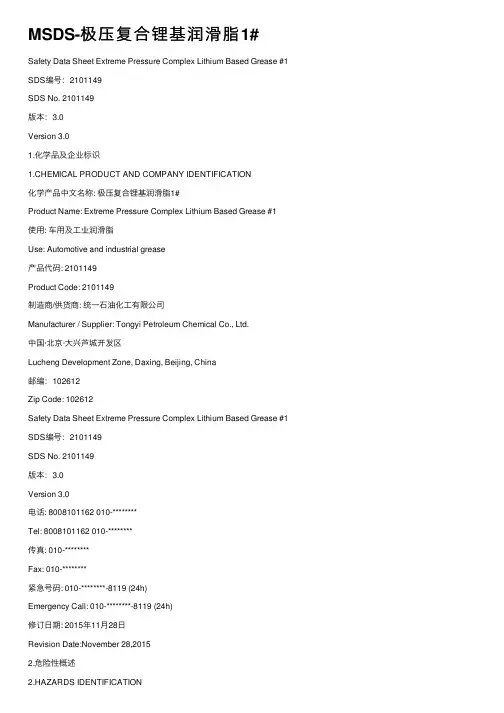
MSDS-极压复合锂基润滑脂1# Safety Data Sheet Extreme Pressure Complex Lithium Based Grease #1 SDS编号:2101149SDS No. 2101149版本:3.0Version 3.01.化学品及企业标识1.CHEMICAL PRODUCT AND COMPANY IDENTIFICATION化学产品中⽂名称: 极压复合锂基润滑脂1#Product Name: Extreme Pressure Complex Lithium Based Grease #1使⽤: 车⽤及⼯业润滑脂Use: Automotive and industrial grease产品代码: 2101149Product Code: 2101149制造商/供货商: 统⼀⽯油化⼯有限公司Manufacturer / Supplier: Tongyi Petroleum Chemical Co., Ltd.中国·北京·⼤兴芦城开发区Lucheng Development Zone, Daxing, Beijing, China邮编:102612Zip Code: 102612Safety Data Sheet Extreme Pressure Complex Lithium Based Grease #1 SDS编号:2101149SDS No. 2101149版本:3.0Version 3.0电话: 8008101162 010-********Tel: 8008101162 010-********传真: 010-********Fax: 010-********紧急号码: 010-********-8119 (24h)Emergency Call: 010-********-8119 (24h)修订⽇期: 2015年11⽉28⽇Revision Date:November 28,20152.危险性概述2.HAZARDS IDENTIFICATION分级分类: ⽆危害。
化学品安全技术说明书(MSDS)1:化学品名称及企业标识产品名称:锂基润滑脂(俗称黄油)用途:车用或普通设备用脂-------------------------------------------------------------------------------------------------------------------------2:组成/成分资料成分:精制矿物油、皂类增稠剂、适当性能添加剂。
此产品不含任何等于或高于规定限值有害成分。
请参阅第八节职业接触限度-------------------------------------------------------------------------------------------------------------------------3:危险标识此产品并不属于危险产品。
但必须按照良好的工业卫生条件和安全操作规程进行使用。
-------------------------------------------------------------------------------------------------------------------------4:急救措施眼:将眼睛张大,用大量水冲洗眼睛。
若眼睛仍有任何红肿、疼痛或不适,应尽快就医。
皮肤:皮肤若接触到油品,应尽快用清水和肥皂彻底加以清洗。
更换严重受污染的衣服,清洗下面弄脏的皮肤。
吸入气体:产品在规定温度下使用不会生烟。
如若吸入高温下产生的油烟造成鼻喉部刺激、或咳嗽,应尽快移至空气新鲜处。
如仍有不适,应送医诊治。
吞服:若污染了口部,应用水彻底冲洗,如有不适,请立即就医。
-------------------------------------------------------------------------------------------------------------------------5:灭火措施适用灭火媒介:使用泡沫、干粉、或水沫,不要用水流。
【化学品安全技术说明书-MSDS】1) 化学品和企业标识化学品中文名长城通用锂基润滑脂00号化学品英文名GREAT WALL Generalduty Lithium Base Grease NO.00产品代码60090303推荐用途和限制用途长城通用锂基润滑脂00号适用于工作温度在-20~120℃范围内各种机械设备的滚动轴承和滑动轴承及其他摩擦部位的润滑。
制造商名称中国石油化工股份有限公司润滑油分公司制造商地址北京市海淀区安宁庄西路6号邮政编码100085企业应急电话00-86-400-810-9886 传真号码00-86-10-82410856网址/电子邮件如果您有关该MSDS内容的相关质询,请发电邮联系********************生效日期2017-12-202) 危险性概述GHS危险性类别无危害GHS标签要素符号无符合警示词无警示词危害说明物理性危害:按照GHS标准,未被归类为有害物质。
健康危害:按照GHS标准,未被归类为健康危害物质。
环境危害按照GHS标准,未被归类为环境危害物质。
GHS预防措施说明预防措施无预防用语事故响应无预防用语安全储存无预防用语废弃处置无预防用语不影响分类的其他危害未被评为可燃物,但会燃烧主要症状和应急综述根据动物试验,没有发现有力证据证明该产品致癌。
通常情况下本产品不会危害健康,过度接触可能会对眼睛、皮肤、呼吸等产生刺激性。
不适当清洗,可能会阻塞皮肤毛孔,导致油脂性粉刺、毛囊炎等疾病。
用过的油可能包含有害杂质。
3) 成分/组成信息配方说明本产品为混合物,主要成分包括脂肪酸锂皂、高度精炼的矿物油和石油添加剂。
化学物质名cas编号或识别编号EC编号含量,wt%脂肪酸锂皂7620-77-1 31-536-5 8-18精炼矿物基础油混合物--- 80-95石油添加剂68649-42-3 272-028-3 6-104) 急救措施一般信息在正常使用条件下使用不应会成为健康危险源。
MSDS 锂基脂化学品安全技术说明书(MSDS):锂基润滑脂1.化学品名称及用途:产品名称为锂基润滑脂,俗称黄油,用于车辆或普通设备的润滑。
2.组成/成分资料:该产品的成分包括精制矿物油、皂类增稠剂以及适当的性能添加剂。
不含任何等于或高于规定限值的有害成分(请参阅第八节职业接触限度)。
3.危险性概述:该产品不属于危险产品,但必须按照良好的工业卫生条件和安全操作规程进行使用。
4.急救措施:眼睛:一旦误入眼睛,应立即用大量清水冲洗,并就医处理。
皮肤:皮肤若接触到油品,应立即用清水和肥皂彻底清洗,并更换严重受污染的衣物。
吸入气体:产品在规定温度下使用不会产生烟雾,但如若吸入高温下产生的油烟造成不适,应立即移至空气新鲜处,并就医处理。
吞服:若污染了口部,应立即用水彻底冲洗,并就医处理。
5.灭火措施:适用灭火媒介:使用泡沫、干粉或水沫,不要用水流。
特殊接触危险:燃烧或遇热可能会发出有毒烟雾。
特别保护仪器:限定空间内的火灾,应该由受训过的人员穿戴好氧气面具进行处理。
可以用水冷却附近的遇热区域/物品/包装;由于有沸溢危险,要避免直接喷射到储存里。
6.泄漏应急处理:个人安全:产品溢出在地上,容易使人滑倒。
环境安全:避免流入去水道、污水渠或其他水道。
解决污染问题的方法是先用集中刮除的方法去除大部分油品,剩余的部分可以使用沙土或其他适当的惰性物质去除。
建议备有足量的适当吸收性物质,以处理可能发生的任何泄漏。
在操作和处置时,应避免与眼睛接触,如果可能会溅出,应戴上适当的全面罩护目镜或化学护目镜。
同时,应避免经常或长期地与新油或旧油有皮肤接触。
任何时候都要保持良好的工作状况、良好的个人卫生和车间清洁,并且接触后应彻底清洗双手。
最后,用后应立即安全地处理掉。
储存时,应确保密闭,存放在遮盖物下,远离热源和火源。
对于该油品,没有专业的暴露限制。
但是应确保良好的通风,尽量避免吸入使用中产生的油气、油烟雾,并且应该控制他们在工作场所空气中的浓度,尽可能使之降至最低。
MSDS-锂基润滑脂(黄油曲奇)化学品安全技术说明书MSDS-锂基润滑脂(黄油曲奇)化学品安全技术说明书1. 基本信息- 产品名称:锂基润滑脂(黄油曲奇)- 产品代码:无- 制造商:___- 123-- 日期:[填写日期]2. 成分信息- 主要成分:锂基润滑脂- 化学名称:[填写化学名称]- CAS号:[填写CAS号]3. 物理和化学性质- 外观:[描述外观]- 颜色:[填写颜色]- 气味:[填写气味]- 相对密度:[填写密度]- 熔点/熔化范围:[填写熔点范围]- 沸点/沸腾范围:[填写沸点范围]- 燃烧性:[填写燃烧性]- 可溶性:[填写可溶性]4. 健康和安全信息- 吸入危害:[填写吸入危害信息]- 食入危害:[填写食入危害信息]- 眼睛接触危害:[填写眼睛接触危害信息] - 皮肤接触危害:[填写皮肤接触危害信息] - 环境危害:[填写环境危害信息]- 急救措施:[填写急救措施信息]5. 消防措施- 火灾危险性:[填写火灾危险性信息]- 爆炸危险性:[填写爆炸危险性信息]- 灭火方法:[填写灭火方法]6. 操作注意事项- 操作注意事项:[填写操作注意事项] - 储存条件:[填写储存条件]- 泄漏处置:[填写泄漏处置方法]7. 运输信息- 包装类别:[填写包装类别]- 运输标志:[填写运输标志]- 运输注意事项:[填写运输注意事项]8. 应急处理- 泄漏处置:[填写泄漏处置方法]- 废弃物处理:[填写废弃物处理方法] - 排放限制:[填写排放限制]9. 特殊性- 特殊用途:[填写特殊用途]- 注意事项:[填写注意事项]请注意以上内容仅为示例,具体填写请参考实际产品信息,并按照相关法律法规要求进行操作。